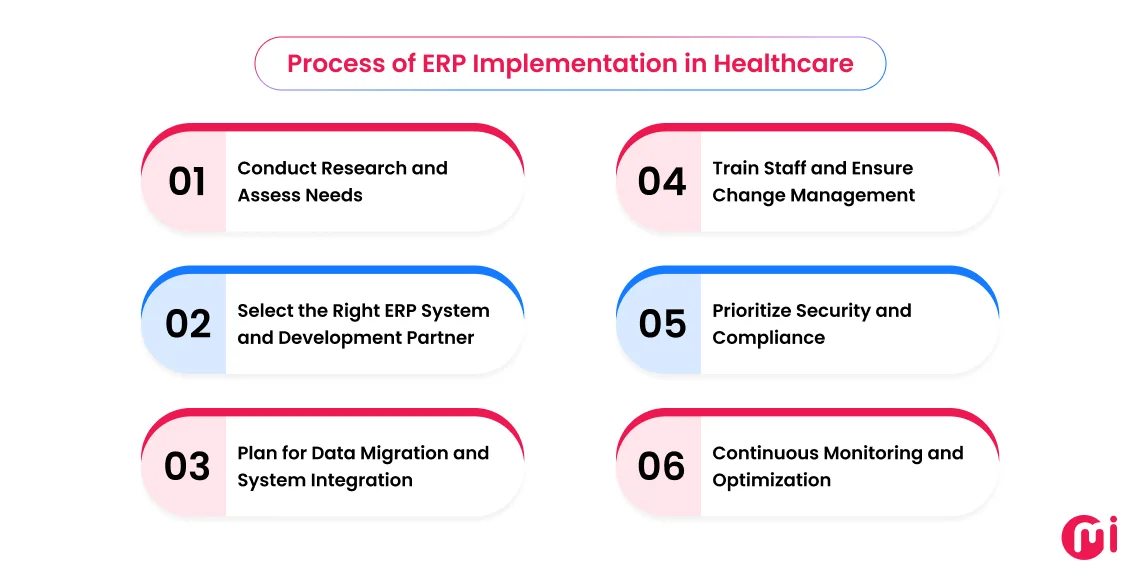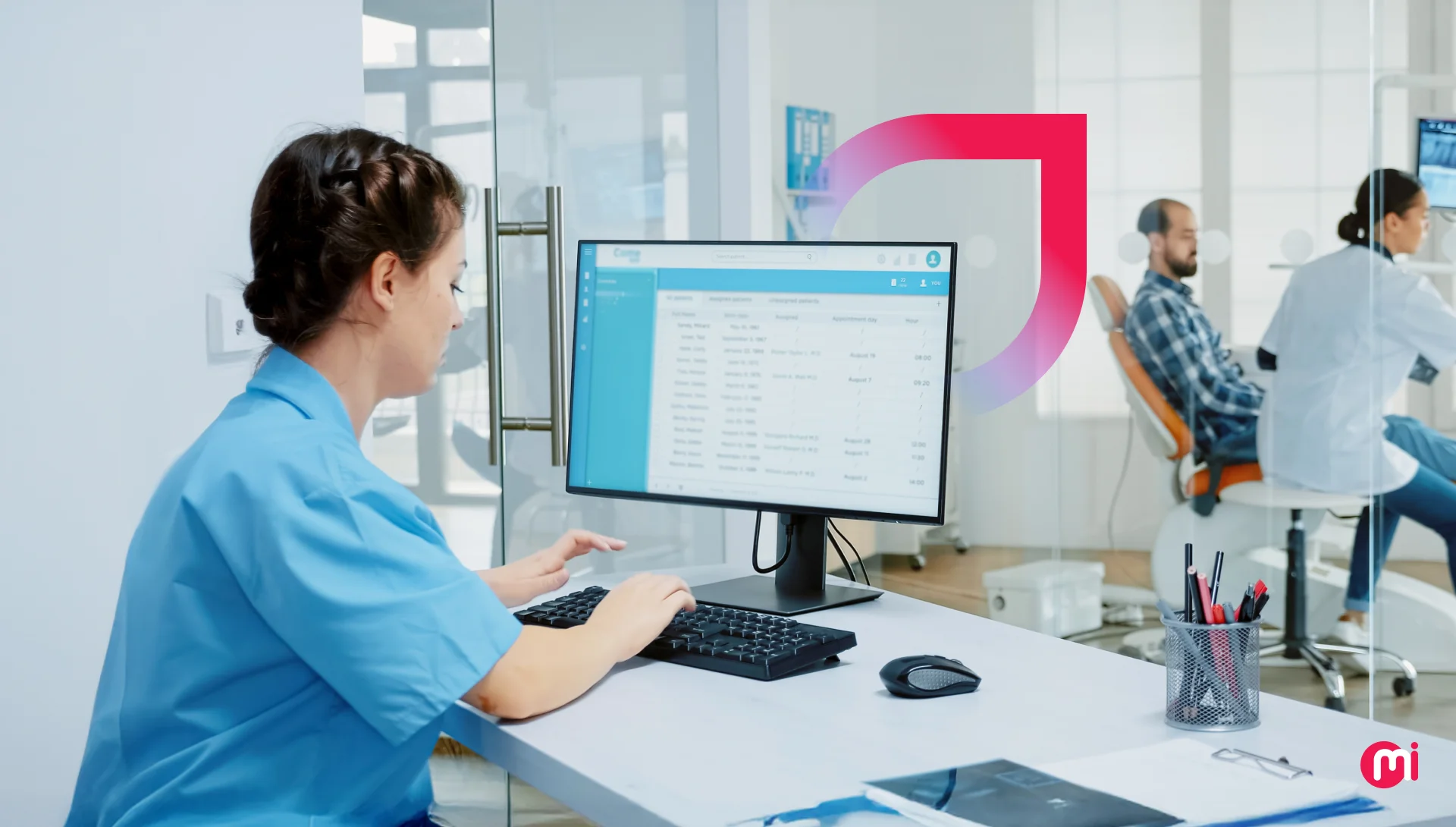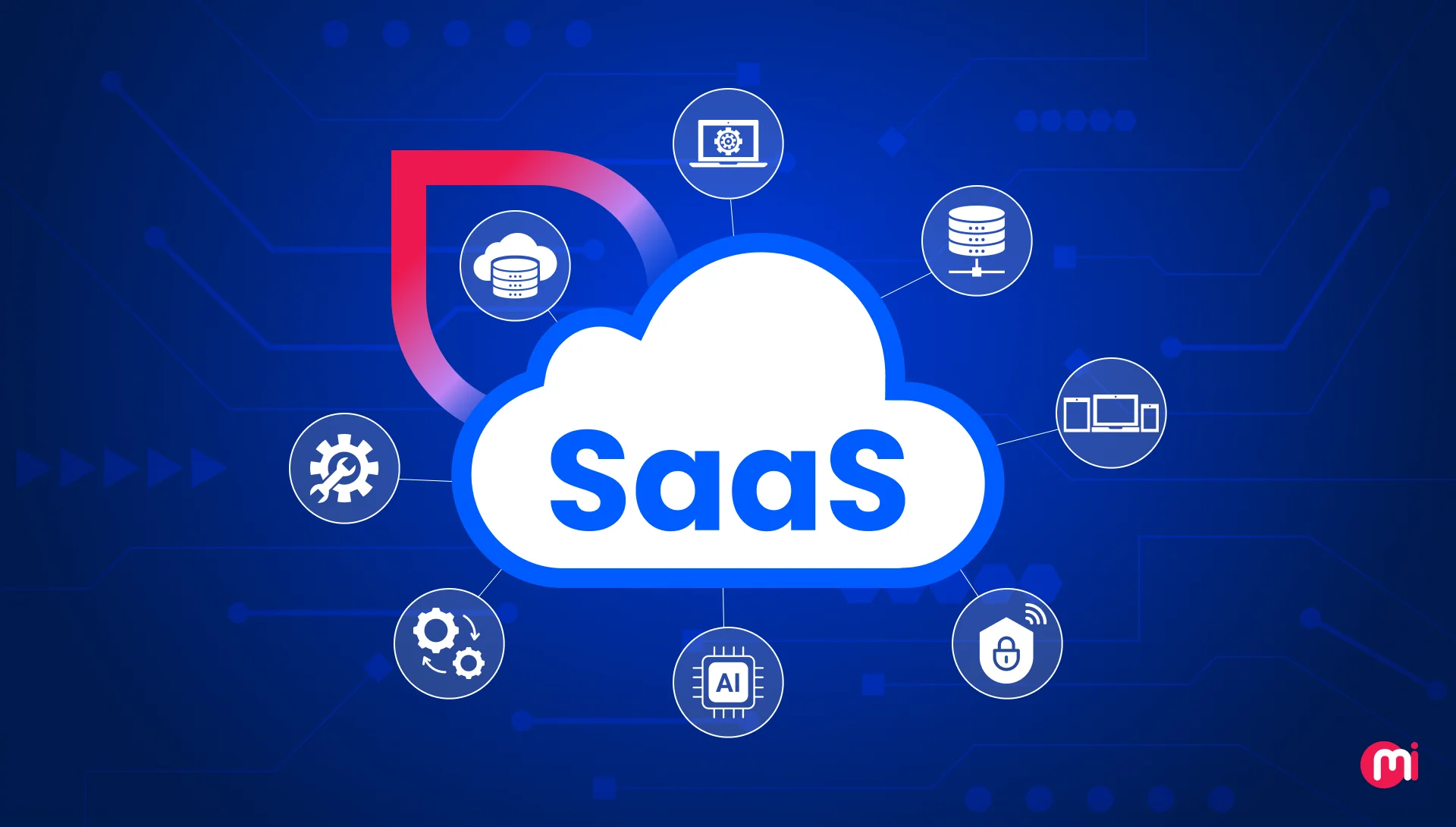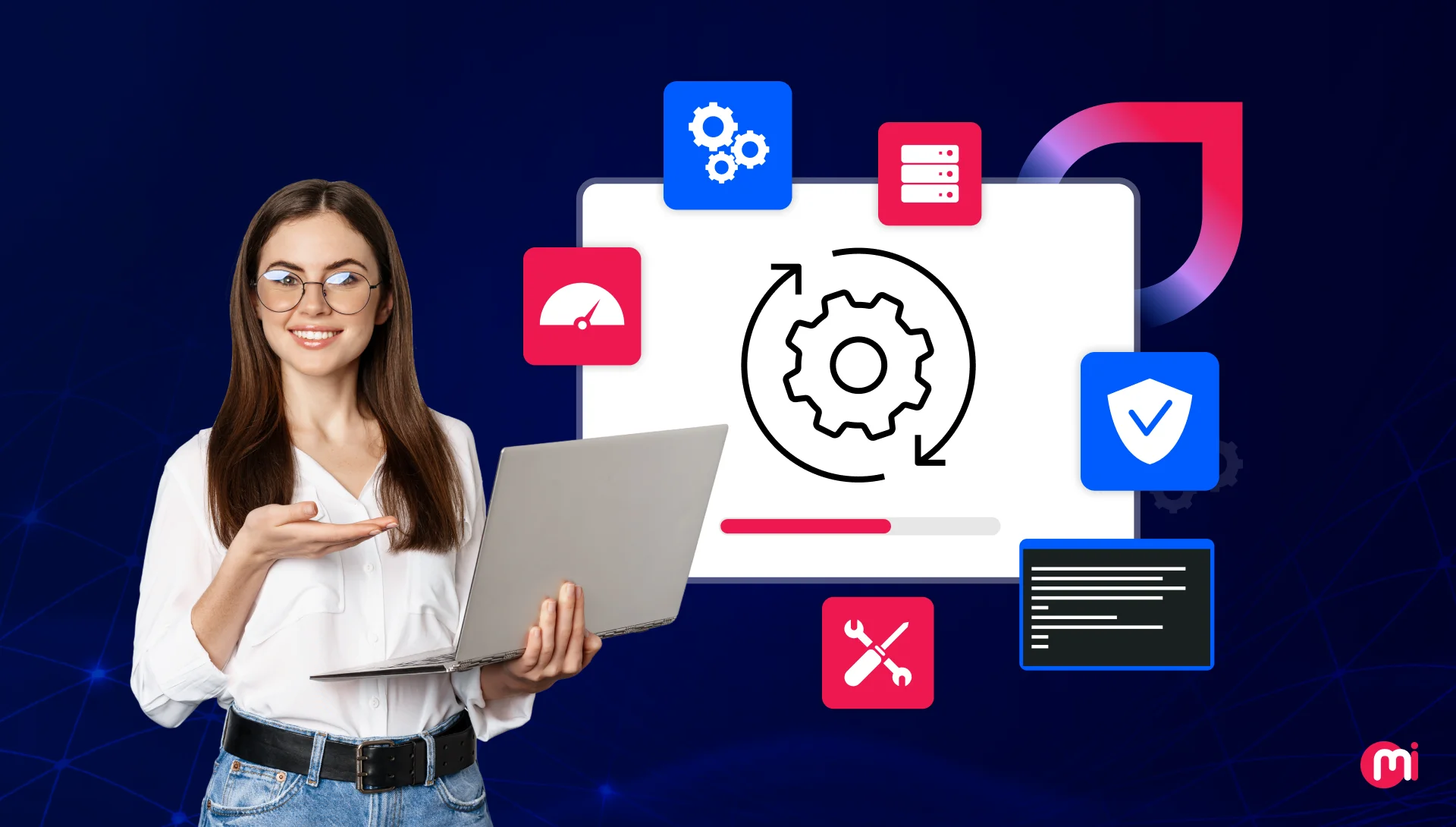ERP in Healthcare: How It’s Shaping the Future of the Healthcare Industry
- Software
- August 7, 2025
ERP in healthcare helps organizations execute all their operations, from patient data and billing to inventory and compliance on a single, integrated platform. It optimizes resources and cuts down errors and transforms how hospitals and clinics operate. This blog highlights how ERP empowers hospitals and clinics to simplify complex workflows, keep data connected, and stay focused on what matters most: delivering exceptional care to every patient.
In the healthcare industry, every second counts, and precision often means the difference between life and death. Hospitals and clinics face constant pressure to operate efficiently while still delivering exceptional patient care. Yet, many organizations struggle with fragmented systems, manual processes, and isolated data that drain resources and hinder critical decision-making.
Implementation of ERP in healthcare serves as a strategic backbone for modern healthcare providers. It connects patient management, inventory, human resources, and compliance into a single system. With ERP, healthcare teams streamline operations, cut down errors, and spend more time focusing on patient care.
This blog explores how healthcare providers use ERP not only to improve back-office efficiency but also to transform care delivery. By driving smarter workflows and empowering staff with real-time information, ERP helps create a healthcare ecosystem that delivers better outcomes for everyone.

What is ERP in Healthcare?
ERP in healthcare refers to Enterprise Resource Planning systems that integrate and manage the various business and clinical processes of a healthcare organization within a single software platform. Unlike standalone systems that handle functions separately, an ERP connects areas like patient scheduling, billing, electronic health records, inventory, human resources, and compliance often developed and customized through healthcare software development service provider to meet specific organizational needs.
This unified approach helps hospitals and clinics streamline operations, reduce manual work, improve data accuracy, and gain real-time insights into their entire organization. By bringing all these functions together, ERP systems enable healthcare providers to operate more efficiently and focus more resources on delivering quality patient care.
Top Benefits of Healthcare ERP Systems
Healthcare ERP systems offer major benefits such as streamlined operations, better patient care, integrated data management, reduced medical errors, cost savings, enhanced resource allocation, and strong security. Here’s a detailed overview of the benefits of ERP in healthcare:
Streamlined Operations
ERP systems automate and connect processes like scheduling, billing, inventory, and HR, reducing manual work and eliminating delays. This helps hospitals and clinics run smoothly and respond quickly to daily demands.
Better Patient Care
With more efficient operations and less administrative burden, doctors and nurses can dedicate more time to patients. Faster access to accurate patient data also supports timely, informed care decisions.
Integrated Data Management
ERP systems unify data from across the organization into a single, secure platform. This ensures everyone works with up-to-date information, breaking down silos between departments and improving collaboration.
Reduced Medical Errors
Centralized, accurate records lower the chances of mistakes due to lost paperwork or outdated information. Clinicians can see complete patient histories and make safer, better-informed treatment choices.
Cost Reduction
ERP systems in healthcare optimize inventory, automate routine tasks, and improve financial oversight, helping healthcare providers cut unnecessary expenses and manage budgets more effectively.
Enhanced Resource Allocation
Real-time insights into staffing, equipment, and supply needs allow managers to deploy resources where they’re needed most. This leads to better use of personnel and critical assets.
Uptight Security
ERP platforms include strong security measures like role-based access, data encryption, and audit trails. This protects sensitive patient and financial data and ensures compliance with healthcare compliance.

Types of ERP Systems in Healthcare
Generally, healthcare ERP systems have three categories, including on-premises, cloud-based, and hybrid models, each providing distinct benefits to healthcare organizations. Here’s a brief overview of the types of ERP systems in healthcare:
1. On-Premise ERP Software
On-premise ERP systems are installed and managed on the organization’s servers. These systems give healthcare providers full control over their data and infrastructure. They’re ideal for organizations with strict internal policies or complex customization needs.
2. Cloud-based ERP Systems
Cloud ERP solutions offer flexibility, scalability, and lower upfront costs as they are hosted by a third-party provider and accessible over the internet. By migrating to cloud, with advanced cloud based ERP software, healthcare organizations can ease the load on internal IT teams, and have a system that’s easier to update, maintain, and scale as needed.
3. Hybrid ERP Systems
Hybrid ERP systems are a combination of both on-premise and cloud models. These systems allow healthcare organizations to keep sensitive data on-site while leveraging the cloud for other functions. This approach balances control, security, and scalability.
Roles and Responsibilities of Healthcare ERP Systems
ERP systems in healthcare handle many important functions that keep hospitals and clinics running smoothly. These roles and responsibilities include centralized data management, streamlining administrative workflows, enhancing financial operations, inventory & supply chain management, regulatory compliance & reporting, optimizing human resources, and data analytics & decision support. Here’s a brief of it:
Centralized Data Management
Unified Data Repository: A healthcare ERP system consolidates all critical data, from patient records and lab results to billing, inventory, and staffing, into one integrated platform. This eliminates scattered, disconnected systems and ensures everyone works from the same accurate information.
Elimination of Data Silos: ERP systems centralize data and break down the walls between departments. Clinical, financial, and operational teams can access and share information seamlessly, improving collaboration and reducing miscommunication.
Streamlining Administrative Workflows
Improved Coordination Between Departments: When administrative workflows run through a unified ERP system, departments like admissions, billing, and medical records stay in sync. This smooth coordination cuts delays and ensures everyone works with the same up-to-date information.
Automation of Routine Tasks: ERP systems handle repetitive administrative processes such as patient registration, appointment scheduling, billing, and claims processing. This reduces manual workload, speeds up operations, and minimizes human error.
Faster Document Management: With digital records managed in one system, staff can quickly create, store, retrieve, and update documents without sifting through piles of paperwork or navigating multiple platforms.
Enhancing Financial Operations
Integrated Billing and Claims Management: ERP systems unify billing, invoicing, and insurance claims within a single platform. This reduces errors, speeds up reimbursements, and ensures payments are tracked accurately from start to finish.
Cost Tracking and Control: Detailed financial modules track expenses across departments, projects, or facilities. This visibility helps identify waste, reduce unnecessary costs, and improve overall financial efficiency.
Real-Time Financial Visibility: With all financial data centralized, administrators can monitor cash flow, outstanding bills, and revenue in real time. This helps identify issues early and supports smarter financial planning.
Inventory & Supply Chain Management
Real-Time Inventory Tracking: ERP systems monitor medical supplies, equipment, and pharmaceuticals in real time. Staff can instantly see stock levels, expiry dates, and reorder points, reducing the chances of shortages or overstocking.
Automated Replenishment: With predefined thresholds, ERP systems can automatically trigger purchase orders when supplies run low. This ensures critical items are always available without manual tracking.
Improved Equipment Utilization: ERP systems track the availability, location, and maintenance schedules of medical equipment. This prevents underuse, reduces downtime, and extends the life of expensive assets.
Regulatory Compliance & Reporting
Audit Readiness: Detailed audit trails track every action taken within the system, from data entry to financial transactions. It simplifies both internal and external audits, helping organizations demonstrate compliance at any time.
Support for Healthcare Standards: ERP platforms are designed to help organizations adhere to key standards like HIPAA, HITECH, and other local health data regulations, protecting patient privacy and organizational integrity.
Optimizing Human Resources
Efficient Staff Scheduling: ERP systems automate shift planning and help match staffing levels to patient demand, reducing scheduling conflicts, minimizing overtime costs, and ensuring adequate coverage across departments.
Payroll and Benefits Management: An integrated ERP platform handles payroll processing, tax calculations, and benefits administration in one place, minimizing errors and saving HR teams valuable time.
Performance Monitoring: With built-in tools for tracking evaluations and KPIs, ERP systems support fair, data-driven performance reviews. It fosters accountability and highlights areas for professional development.
Data Analytics & Decision Support
Real-Time Operational Insights: ERP systems continuously collect and analyze data from across the organization, including patient flow, inventory, staffing, and finances, providing leaders with up-to-date insights to monitor day-to-day operations.
Predictive Analytics: Advanced ERP platforms use historical and current data to forecast future needs, such as patient volumes or supply demands. This helps healthcare organizations prepare proactively and allocate resources more effectively.
Evidence-Based Decision Making: ERP systems provide comprehensive, accurate data that empower leaders to base strategic decisions on clear trends and solid evidence rather than assumptions or fragmented reports.

Must-Have Features in Modern Healthcare ERP Systems
Modern healthcare ERP systems include several essential features that keep operations efficient and connected. Some of the most important ones are patient data management, EMR/EHR integration, business intelligence, clinical documentation, data analytics & dashboards, robust security & access controls, automation, and cloud-based ERP. Here’s a concise rundown:
Patient Data Management
Manages and organizes all patient-related information, including personal details, medical histories, allergies, lab results, and treatment records within a centralized system.
EMR/EHR Integration
Connects the ERP system with Electronic Medical Records (EMR) or Electronic Health Records (EHR) platforms to ensure seamless exchange and synchronization of clinical data.
Business Intelligence
Includes tools for collecting, processing, and visualizing data from various departments, offering detailed reports, dashboards, and analytical models tailored to healthcare operations.
Clinical Documentation
Provides structured templates and modules for recording clinical notes, treatment plans, physician observations, and other patient care documentation directly within the ERP system.
AI Chatbots
AI chatbots in healthcare organizations handle routine patient queries, appointment reminders, and basic triage, improving response times and patient engagement.
Data Analytics & Dashboards
Offers built-in analytical capabilities and interactive dashboards that compile and display data from across the organization in a visual, easily digestible format.
Robust Security & Access Controls
Implements layered security features such as encryption, user authentication, and permission-based access to ensure only authorized individuals can view or modify sensitive data.
Automation
Enables automatic execution of routine processes like patient scheduling, billing cycles, inventory reordering, and compliance checks through configurable workflows.
Cloud-Based ERP
Runs the ERP software on remote servers accessible via the internet, supported by a secure cloud infrastructure that hosts and maintains all applications and data.

How to Successfully Implement ERP in Healthcare?
The process of ERP implementation in healthcare demands a clear plan, the right software, and strong support for your team. You need to plan data migration carefully, train staff well, keep security tight, and watch the system to keep improving. Take a quick look at the process to know how it unfolds:

1. Conduct Research and Assess Needs
Before selecting or designing an ERP system, thoroughly evaluate your organization’s current operations, challenges, and goals. Map out existing processes across departments like billing, inventory, patient management, and HR to identify gaps and inefficiencies. Engage stakeholders, from clinicians to administrative staff, to understand their pain points and requirements.
Research available ERP solutions to see which ones best address these needs and comply with healthcare regulations. This groundwork ensures you choose or build a system tailored to your organization’s specific workflows and strategic objectives.
2. Select the Right ERP System and Development Partner
Select an ERP system that aligns with your healthcare organization’s size, complexity, and specific operational needs. Evaluate vendors based on their experience in the healthcare sector, the ability of their systems to integrate with existing EHR or EMR platforms, and support for regulatory compliance.
Also, consider scalability, customization options, and whether you need an on-premises, cloud-based, or hybrid deployment. Involve key users in demonstrations and decision-making to ensure the chosen ERP fits your workflows and can adapt as your organization grows.
3. Plan for Data Migration and System Integration
Develop a detailed strategy to move existing patient records, financial data, inventory logs, and HR files from legacy systems into the new ERP. Identify what data needs to be cleaned, standardized, or archived to ensure accuracy and consistency.
Also, plan how the ERP will integrate with essential systems like EHRs, lab software, or billing platforms to maintain seamless data flow. Careful mapping and testing of these integrations help prevent disruptions and ensure that all departments can continue working without interruptions.
4. Train Staff and Ensure Change Management
Provide hands-on training to clinical and administrative staff, billing departments, and IT on how to use the new ERP in their daily work. Explain the purpose behind adopting the system and show how it will improve patient care and operations.
Keep communication open, answer questions, and appoint change champions in each department to guide their colleagues. Actively involve staff and address concerns early to help everyone embrace the new system.
5. Prioritize Security and Compliance
Use strong encryption and strict access controls to protect patient and operational data. Follow healthcare regulations like HIPAA or local laws to maintain compliance. Run security audits regularly and monitor system activity to catch issues early. Keep patient privacy safe and shield your organization from legal risks through consistent, proactive security measures.
6. Continuous Monitoring and Optimization
Track system performance through dashboards, user feedback, and routine audits. Identify slowdowns or gaps and adjust workflows or configurations to keep everything running smoothly. Look for ways to streamline processes, add useful features, and improve data quality. Stay proactive so your ERP continues to support patient care and operational goals without falling behind your needs.

How Much Does It Cost to Build ERP Software for the Healthcare Industry?
ERP software development cost for the healthcare industry typically ranges from $60,000 to $300,000+ or more. However, the final cost to develop ERP depends on various factors such as organizational size, feature complexity, and customization requirements. For small to mid-sized healthcare providers, investment usually falls between $40,000 to $200,000+, while larger enterprises often spend $500,000 or more to build a robust, fully tailored system.
What’s the Future of ERP in the Healthcare Industry?
The future of ERP in the healthcare industry will bring more automation, smarter AI tools, cloud-first systems, and a bigger focus on patient needs. ERP platforms are growing to meet the demands of modern healthcare, helping organizations work more efficiently, deliver better care, and stay compliant with regulations. Here is a closer look at the trends that show just how much these systems are set to transform healthcare.
Greater Cloud Adoption
More healthcare organizations will shift to cloud-based or hybrid ERP systems. These cloud solutions or hybrid ERP systems cut down on infrastructure costs, simplify upgrades, and allow teams to access critical data anytime, anywhere.
Artificial Intelligence
AI in ERP platforms is the present and will be leveraged heavily in the future. Especially AI in healthcare will be used to predict patient volumes, optimize staff schedules, and spot trends that lead to better outcomes.
Deeper Integrations
Next-generation ERPs will connect seamlessly with telehealth platforms, IoT medical devices, wearable trackers, and patient apps. This integration will give providers a complete, real-time view of patient health beyond the clinic walls.
Stronger Security and Compliance
As data breaches and regulations grow, ERP systems will add advanced encryption, access controls, and automated compliance features. These improvements will help organizations safeguard patient data and avoid penalties.
More Personalized Care
ERPs won’t just manage operations; they’ll also enable personalized care. By pulling insights from patient histories and health patterns, these systems will help tailor treatments, reminders, and engagement strategies to individual needs.
Also read: The Role of AI and ML in Revolutionizing Healthcare
Conclusion
Healthcare will always center around people, patients seeking comfort, families hoping for answers, and professionals dedicating their lives to healing. ERP systems may seem like just another piece of technology, but in reality, they quietly power the heartbeat of modern care. They untangle complex processes, put critical information at caregivers’ fingertips, and create space for hospitals to grow without losing their personal touch.
As more healthcare organizations embrace ERP, they’re not just investing in smoother operations but building a stronger foundation for compassion, trust, and better outcomes. That’s a future worth striving for.

How Does Mindinventory Help Businesses Succeed Through Custom ERP Solutions?
Mindinventory stands out as a trusted custom software development company for businesses seeking robust, scalable ERP systems tailored to their industry needs. We provide end-to-end ERP software development services that handle the rigorous demands of modern healthcare.
We design ERP systems with modular architectures and interoperable frameworks that easily integrate with existing EHR, EMR, RIS, and LIS platforms. This creates a unified data environment where patient information, clinical workflows, billing, and supply chain data stay connected and always accessible.
We also leverage AI and advanced analytics to power predictive modeling, whether forecasting patient admissions, optimizing staff schedules, or identifying trends that impact care quality and resource allocation. With real-time dashboards and smart reporting, healthcare leaders gain the insights needed to make informed decisions quickly.
We embed automation and IoT capabilities to track medical assets, monitor inventory levels, and reduce manual errors, helping organizations cut costs and maintain high standards of care. This partnership brings in-depth technical expertise, healthcare domain knowledge, and a commitment to delivering ERP solutions that truly shape how your organization provides care and runs its operations.
FAQs on ERP in Healthcare
Epic Systems is widely regarded as the most popular ERP-like platform in healthcare, known for its comprehensive integration of clinical, financial, and operational functions. Other major players include Cerner, Infor Healthcare, WebPT, NextGen Healthcare, eClinicalWorks, etc. These systems help hospitals and large healthcare networks streamline workflows, centralize data, and support better patient care.
The three leading ERP systems across industries, including healthcare, are generally considered to be SAP, Oracle, and Microsoft Dynamics 365. These platforms stand out for their robust features, scalability, and flexibility, making them a popular choice for large and mid-sized organizations looking to integrate financial, operational, and human resources processes into a single system.
A clinical ERP is an integrated system that manages both administrative and clinical processes in healthcare. It combines traditional ERP functions like finance and inventory with patient care activities such as EHR and treatment workflows. This helps streamline operations, improve care, and support data-driven decisions.
An EHR (Electronic Health Record) focuses on storing and managing patient medical data, like histories, diagnoses, and treatment plans. An ERP (Enterprise Resource Planning) system manages the broader operations of a healthcare organization, including finance, HR, inventory, and sometimes clinical workflows.
No, an ERP (Enterprise Resource Planning) system is not a CMS (Content Management System). ERP manages and integrates business processes like finance, HR, inventory, and supply chain across an organization. In contrast, a CMS is designed to create, manage, and publish digital content, such as websites or blogs. They serve very different purposes, as ERP streamlines operations, while CMS handles content.













